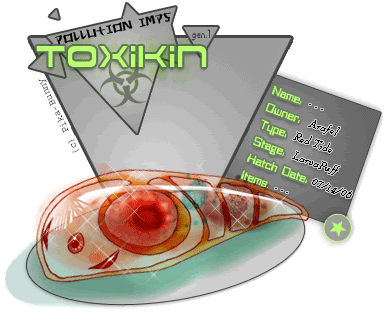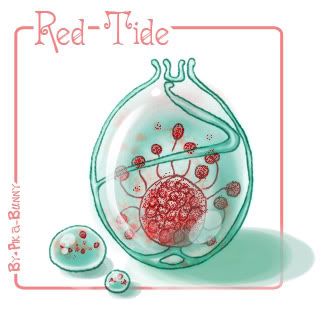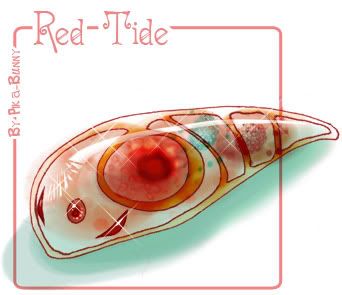|
|
|
|
|
|
|
|
|
 Posted: Sat Jul 01, 2006 9:07 pm Posted: Sat Jul 01, 2006 9:07 pm
 You have come to the Notebook of Arafel and - - -. Please do not post unless you have their permission. You have come to the Notebook of Arafel and - - -. Please do not post unless you have their permission.
About Red Tide Red tide is estuarine or marine algal bloom. Red tide is caused by species of dinoflagellates, often present in sufficient numbers (thousands or millions of cells per milliliter) to turn the water red or brown. Coastal water pollution produced by humans and systematic increase in sea water temperature appear to be causal factors in red tides. Increases in occurance are correlated with a marine temperature rise of about one degree Celsius, and also with increased nutrient loading into ocean waters. Additionally, red tide can assume its dormant form if the water cools to a sufficient degree. When it does this it forms cysts which drop to the ocean floor and rebloom if the right conditions occur. As another example, non- red tide algal blooms in lakes and rivers may be caused by greatly increased amounts of phosphorus or nitrogen entering an aquatic ecosystem, from either sewage systems, or surface runoff of agricultural fertilizers. Some red tides produce large quantities of toxins, such as saxitoxin, which disrupt the proper function of ion channels in neurons. Domoic acid, causative of neurological damage in certain marine mammals, is one toxin associated with red tides. The red tide toxins can induce neurological damage and death in marine mammals which feed on affected filter feeders, these include whales, seals, and otters. Red tide can also increase fish mortality; they are also accumulated in the digestive tracts of filter feeders. This bioaccumulation of toxins causes bivalves – like oysters and clams – collected in areas affected by algal blooms to be potentially dangerous for human consumption. Initial signs of poisoning from this toxin is tingling in the lips followed by a reduction of motor abilities and difficulty breathing and can be fatal if consumed in sufficient amounts. If these symptoms occur after eating shellfish, seek immediate medical treatment. Standard medical treatment is to give victims oxygen, or to hook them up to a breather. There exists no antidote, and the idea is to keep the person alive until the toxin has passed from the system. There is more than one type of red tide, something that frequently goes unnoticed. For example, the red tide that effects the Gulf Region produces, in addition to the toxins that accumulate within filter feeders, an airborne vector that can cause difficulty breathing, especially for those with preexisting conditions whereas that which occurs in the Northeast US doesn't have an airborne vector. It should also be noted that red tide is far from being entirely understood.
Please keep it in salty water.
It should hatch in 5-10 days.
Update: Hatched July 14th, 2006...
|
 |
 |
|
|
|
|
|
|
|
|
|
|
|
|
 Posted: Sun Jul 23, 2006 1:31 am Posted: Sun Jul 23, 2006 1:31 am
01. Official post
02. Directory
03. Rules
04. Toxikin
05. About Red Tide
06. Caretaker
07. Story
08. Photos
09. Friends
10. Family
11. Items
12. Housing
13. RP log
14.
15. Credits
|
 |
 |
|
|
|
|
|
|
|
|
|
|
|
|
|
|
|
 Posted: Sun Jul 23, 2006 1:42 am Posted: Sun Jul 23, 2006 1:42 am
|
|
|
|
|
|
|
|
|
|
 Posted: Sun Jul 23, 2006 1:43 am Posted: Sun Jul 23, 2006 1:43 am
|
|
|
|
|
|
|
|
|
|
|
|
|
 Posted: Sun Jul 23, 2006 2:30 am Posted: Sun Jul 23, 2006 2:30 am
Red Tide:
Red tide is estuarine or marine algal bloom. Red tide is caused by species of dinoflagellates, often present in sufficient numbers (thousands or millions of cells per milliliter) to turn the water red or brown. The species responsible for red tides on the gulf coast of Florida is a dinoflagellate called Karenia brevis (formerly Gymnodinium breve.) It produces brevetoxins which produce respiratory irritation in humans.
Coastal water pollution produced by humans and systematic increase in sea water temperature appear to be causal factors in red tides. On the Pacific Coast of the U.S. there have been apparent increases in the occurrence of red tides since about 1991. These increases are correlated with a marine temperature rise of about one degree Celsius, and also with increased nutrient loading into ocean waters. Additionally, red tide can assume its dormant form if the water cools to a sufficient degree. When it does this it forms cysts which drop to the ocean floor and rebloom if the right conditions occur. As another example, non- red tide algal blooms in lakes and rivers may be caused by greatly increased amounts of phosphorus or nitrogen entering an aquatic ecosystem from either sewage systems or surface runoff of agricultural fertilizers. Some red tides on the Pacific coast have also been linked to occurrences of El Nino events. Red tides also occur in places where there are no obvious associated human activities.
Some red tides produce large quantities of toxins, such as saxitoxin, which disrupt the proper function of ion channels in neurons. Domoic acid, causative of neurological damage in certain marine mammals, is one toxin associated with red tides. The red tide toxins can induce neurological damage and death in marine mammals which feed on affected filter feeders, these include whales, seals, and otters. Red tide can also increase fish mortality; they are also accumulated in the digestive tracts of filter feeders. This bioaccumulation of toxins causes bivalves – like oysters and clams – collected in areas affected by algal blooms to be potentially dangerous for human consumption. Initial signs of poisoning from this toxin is tingling in the lips followed by a reduction of motor abilities and difficulty breathing and can be fatal if consumed in sufficient amounts. If these symptoms occur after eating shellfish, seek immediate medical treatment. Standard medical treatment is to give victims oxygen, or to hook them up to a breather. There exists no antidote, and the idea is to keep the person alive until the toxin has passed from the system.
There is more than one type of red tide, something that frequently goes unnoticed. For example, the red tide that effects the Gulf Region produces, in addition to the toxins that accumulate within filter feeders, an airborne vector that can cause difficulty breathing, especially for those with preexisting conditions, whereas that which occurs in the Northeast US has no airborne vector component. It should also be noted that red tide is far from being entirely understood.
Gymnocin A is a cytotoxic polyether and a typical representative of toxins associated with red tide
NeuroToxins:
A neurotoxin is a toxin that acts specifically on nerve cells – neurons – usually by interacting with membrane proteins and ion channels. Many of the venoms and other toxins that organisms use in defense against vertebrates are neurotoxins. A common effect is paralysis, which sets in extremely rapidly. Examples of neurotoxins include tetrodotoxin, batrachotoxin and components of the venom in bees, scorpions, spiders and snakes.
Toxins taken in from the environment are described as exogenous and include gases (eg carbon monoxide), metals (such as mercury), liquids (ethanol) and an endless list of solids. When exogenous toxins are taken in, the effect on neurons is largely dependent on dosage. Thus ethanol (alcohol) is inebriating in low doses, only producing mild neurotoxicity. Prolonged exposure to "safe" alcohol levels slowly weakens and kills neurons.
Neurotoxicity also occurs from substances produced within the body - endogenous neurotoxins. A prime example of a neurotoxin in the brain is glutamate, which is paradoxically also a primary neurotransmitter. When the glutamate concentration around a neuron reaches a critical point the neuron kills itself by a process called apoptosis. This whole process is called excitotoxicity, so named because glutamate normally acts as an excitatory neurotransmitter at lower levels.
A potent neurotoxin such as batrachotoxin affects the nervous system by causing depolarization of nerve and muscle fibres due to increased sodium ion permeability of the excitable cell membrane.
dinoflagellates:
The dinoflagellates are a large group of flagellate protists. Most are marine plankton, but they are common in fresh water habitats as well; their populations are distributed depending on temperature, salinity, or depth. About half of all dinoflagellates are photosynthetic, and these make up the largest group of eukaryotic algae aside from the diatoms. Being primary producers make them an important part of the aquatic food chain. Some species, called zooxanthellae, are endosymbionts of marine animals and protozoa, and play an important part in the biology of coral reefs. Other dinoflagellates are colorless predators on other protozoa, and a few forms are parasitic.
Dino Morphology:
Most dinoflagellates are unicellular forms with two dissimilar flagella. One of these extends towards the posterior, called the longitudinal flagellum, while the other forms a lateral circle, called the transverse flagellum. In many forms these are set into grooves, called the sulcus and cingulum. The transverse flagellum provides most of the force propelling the cell, and often imparts to it a distinctive whirling motion, which is what gives the name dinoflagellate refers to (Greek dinos, whirling). The longitudinal acts mainly as the steering wheel, but providing little propulsive force as well.
Dinoflagellates have a complex cell covering called an amphiesma, composed of flattened vesicles, called alveoli. In some forms, these support overlapping cellulose plates that make up a sort of armor called the theca. These come in various shapes and arrangements, depending on the species and sometimes stage of the dinoflagellate. Fibrous extrusomes are also found in many forms. Together with various other structural and genetic details, this organization indicates a close relationship between the dinoflagellates, Apicomplexa, and ciliates, collectively referred to as the alveolates.
The chloroplasts in most photosynthetic dinoflagellates are bound by three membranes, suggesting they were probably derived from some ingested alga, and contain chlorophylls a and c and fucoxanthin, as well as various other accessory pigments. However, a few have chloroplasts with different pigmentation and structure, some of which retain a nucleus. This suggests that chloroplasts were incorporated by several endosymbiotic events involving already colored or secondarily colorless forms. The discovery of plastids in Apicomplexa have led some to suggest they were inherited from an ancestor common to the two groups, but none of the more basal lines have them.
All the same, the dinoflagellate still consists of the more common organelles such as rough and smooth endoplasmic reticulum, Golgi apparatus, mitochondria, lipid and starch grains, and food vacuoles. Some have even been found with light sensitive organelle such as the eyespot or a larger nucleus containing a prominent nucleolus.
Dino Lifecycle:
Dinoflagellates have a peculiar form of nucleus, called a dinokaryon, in which the chromosomes are attached to the nuclear membrane. These lack histones and remained condensed throughout interphase rather than just during mitosis, which is closed and involves a unique external spindle. This sort of nucleus was once considered to be an intermediate between the nucleoid region of prokaryotes and the true nuclei of eukaryotes, and so were termed mesokaryotic, but now are considered advanced rather than primitive traits.
In most dinoflagellates, the nucleus is dinokaryotic throughout the entire life cycle. They are usually haploid, and reproduce primarily through fission, but sexual reproduction also occurs. This takes place by fusion of two individuals to form a zygote, which may remain mobile in typical dinoflagellate fashion or may form a resting dinocyst, which later undergoes meiosis to produce new haploid cells.
However, when the conditions become desperate, usually starvation or no light, their normal routines change dramatically. Two dinoflagellates will fuse together forming a planozygote. Next is a stage not much different from hibernation called hypnozygote when the organism takes in excess fat and oil. At the same time its shape is getting fatter and the shell gets harder. Sometimes even spikes are formed. When the weather allows it, these dinoflagellates break out of their shell and are in a temporary stage, planomeiocyte, when they quickly reforms their individual thecae and return to the dinoflagellates at the beginning of the process.
Dino Cautions:
Red Tide is more specifically produced when dinoflagellates are able to reproduce rapidly and copiously on account of the abundant nutrients in the water. Although the resulting red waves are a miraculous sight, they, again, contain toxins that not only affect all marine life in the ocean but the people who consume them as well. A specific carrier is shellfish. This can introduce both non-fatal and fatal illnesses. Human inputs of phosphate further encourage these red tides, and consequently there is a strong interest in learning more about dinoflagellates, from both medical and economic perspectives.
All from http://en.wikipedia.org/
|
 |
 |
|
|
|
|
|
|
|
|
|
|
|
|
 Posted: Sun Jul 23, 2006 2:52 am Posted: Sun Jul 23, 2006 2:52 am
|
|
|
|
|
|
|
|
|
|
|
|
|
 Posted: Sun Jul 23, 2006 2:55 am Posted: Sun Jul 23, 2006 2:55 am
|
|
|
|
|
|
|
|
|
|
 Posted: Tue Jul 25, 2006 3:33 pm Posted: Tue Jul 25, 2006 3:33 pm
|
|
|
|
|
|
|
|
|
|
|
|
|
 Posted: Tue Jul 25, 2006 3:41 pm Posted: Tue Jul 25, 2006 3:41 pm
|
|
|
|
|
|
|
|
|
|
 Posted: Tue Jul 25, 2006 4:05 pm Posted: Tue Jul 25, 2006 4:05 pm
|
|
|
|
|
|
|
|
|
|
|
|
|
 Posted: Tue Jul 25, 2006 4:49 pm Posted: Tue Jul 25, 2006 4:49 pm
|
|
|
|
|
|
|
|
|
|
 Posted: Tue Jul 25, 2006 5:59 pm Posted: Tue Jul 25, 2006 5:59 pm
|
|
|
|
|
|
|
|
|
|
|
|
|
 Posted: Tue Jul 25, 2006 6:01 pm Posted: Tue Jul 25, 2006 6:01 pm
|
|
|
|
|
|
|
|
|
|
 Posted: Tue Jul 25, 2006 7:32 pm Posted: Tue Jul 25, 2006 7:32 pm
|
|
|
|
|
|
|
|
|
|
|
|
|
 Posted: Tue Jul 25, 2006 7:55 pm Posted: Tue Jul 25, 2006 7:55 pm
Photo for banner -- PJS Franks
Banners -- Me? XD
Toxikin -- Pika <33
|
 |
 |
|
|
|
|
|
|
|
|
 |
|
|
|
|
|
|



















